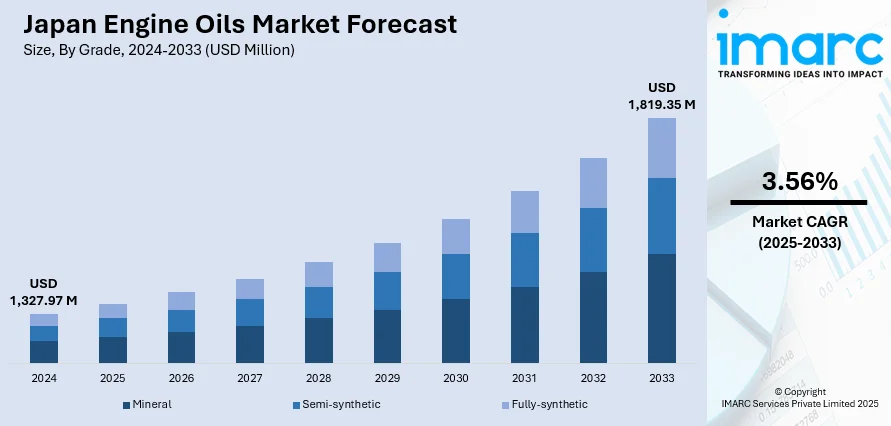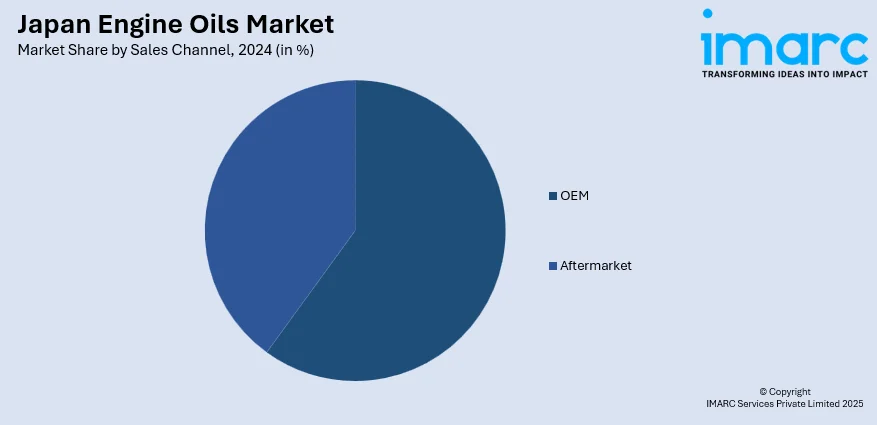
Japan Engine Oils Market Size, Share, Trends and Forecast by Grade, Sales Channel, Engine Type, Vehicle Type, and Region, 2025-2033
Japan Engine Oils Market Overview:
The Japan engine oils market size reached USD 1,327.97 Million in 2024. Looking forward, IMARC Group expects the market to reach USD 1,819.35 Million by 2033, exhibiting a growth rate (CAGR) of 3.56% during 2025-2033. The market is driven by a mature automotive sector, strict environmental regulations, and a shift toward fuel-efficient, synthetic lubricants. Innovations in hybrid and electric vehicle technologies also influence product development and demand patterns. Established players focus on sustainability and performance to stay competitive, shaping the dynamics of the Japan engine oils market share.
|
Report Attribute
|
Key Statistics
|
|---|---|
|
Base Year
|
2024
|
|
Forecast Years
|
2025-2033
|
|
Historical Years
|
2019-2024
|
| Market Size in 2024 | USD 1,327.97 Million |
| Market Forecast in 2033 | USD 1,819.35 Million |
| Market Growth Rate 2025-2033 | 3.56% |
Japan Engine Oils Market Trends:
Advanced Automotive Industry and Vehicle Ownership
Japan’s engine oils market is deeply influenced by its highly developed automotive industry and widespread vehicle ownership. Home to leading automakers like Toyota, Honda, and Nissan, Japan maintains a robust demand for high-performance lubricants that meet the evolving needs of advanced engine technologies. For Japanese consumers, dependable cars last longer, leading to them being well-maintained and having regular oil changes. Due to the increase in hybrid and turbocharged engines, manufacturers require engine oils built for higher engine temperatures and more pressure. Additionally, the presence of service centers and dealerships makes it easy for customers to get high-quality lubricants. As a result, companies need to focus on tech and development since what consumers buy and what oil is made from is strongly affected.

To get more information on this market, Request Sample
Aging Vehicle Fleet and Preventive Maintenance Culture
Japan has one of the oldest vehicle fleets among developed countries, with many vehicles remaining on the road well past their typical lifecycle. This trend drives demand for engine oils that provide superior wear protection, thermal stability, and sludge resistance. Preventive maintenance is deeply embedded in Japanese vehicle ownership culture, reinforced by mandatory inspection programs like the “Shaken,” which require vehicle owners to adhere to strict maintenance schedules. This results in consistent demand for lubricants suitable for both newer and aging engines. Many consumers prefer engine oils with specialized additives designed to enhance the performance and durability of older vehicles. Combined with a highly service-oriented automotive aftermarket, this culture ensures a stable and recurring demand for high-quality lubricants across the nation.
Technological Innovation and OEM Collaboration
Technological innovation and collaboration with original equipment manufacturers (OEMs) are crucial factors driving the Japan engine oils market growth. Japanese automakers are at the forefront of engine design advancements, especially in hybrid, plug-in hybrid, and turbocharged engine systems. To meet the performance demands of these complex engines, lubricant manufacturers invest heavily in R&D to develop tailored engine oils with advanced additives and formulations. Close cooperation between OEMs and lubricant producers ensures that oil products meet exact engine specifications, support warranty compliance, and enhance overall vehicle efficiency. This synergy fosters innovation, brand trust, and long-term customer loyalty. As engine technologies evolve to meet environmental and performance goals, the role of custom-engineered lubricants becomes increasingly central to automotive strategy and product competitiveness.
Japan Engine Oils Market Segmentation:
IMARC Group provides an analysis of the key trends in each segment of the market, along with forecasts at the country and regional levels for 2025-2033. Our report has categorized the market based on grade, sales channel, engine type, and vehicle type.
Grade Insights:
- Mineral
- Semi-synthetic
- Fully-synthetic
The report has provided a detailed breakup and analysis of the market based on the grade. This includes mineral, semi-synthetic, and fully-synthetic.
Sales Channel Insights:

- OEM
- Aftermarket
A detailed breakup and analysis of the market based on sales channel have also been provided in the report. This includes OEM and aftermarket.
Engine Type Insights:
- Gasoline
- Diesel
A detailed breakup and analysis of the market based on the engine type have also been provided in the report. This includes gasoline and diesel.
Vehicle Type Insights:
- Passenger Cars
- Light Commercial Vehicles
- Heavy Commercial Vehicles
- Two Wheelers
A detailed breakup and analysis of the market based on the vehicle type have also been provided in the report. This includes passenger cars, light commercial vehicles, heavy commercial vehicles, and two wheelers.
Regional Insights:
- Kanto Region
- Kansai/Kinki Region
- Central/ Chubu Region
- Kyushu-Okinawa Region
- Tohoku Region
- Chugoku Region
- Hokkaido Region
- Shikoku Region
The report has also provided a comprehensive analysis of all the major regional markets, which include the Kanto Region, Kansai/Kinki Region, Central/ Chubu Region, Kyushu-Okinawa Region, Tohoku Region, Chugoku Region, Hokkaido Region, and Shikoku Region.
Competitive Landscape:
The market research report has also provided a comprehensive analysis of the competitive landscape. Competitive analysis such as market structure, key player positioning, top winning strategies, competitive dashboard, and company evaluation quadrant has been covered in the report. Also, detailed profiles of all major companies have been provided.
Japan Engine Oils Market News:
- In February 2025, a novel racing engine oil developed by a Japanese business has the potential to revolutionize our understanding of sustainability in high-performance automobiles. This cutting-edge oil, known as Idemitsu IFG Plantech Racing, satisfies the exacting requirements of the American Petroleum Institute's SP accreditation and is composed of more than 80% plant-based components.
- In August 2024, Idemitsu Kosan Co., Ltd. created a new engine oil, Idemitsu Kosan Co., Ltd. developed a new engine oil, IDEMITSU IFG Plantech Racing (viscosity grade: 0W-20), composed of more than 80% plant-derived raw materials (hereafter called “the Material”). The item is the world's inaugural engine oil with racing capabilities to obtain API (American Petroleum Institute) SP certification and API SP certification made from plant-derived materials.
Japan Engine Oils Market Report Coverage:
| Report Features | Details |
|---|---|
| Base Year of the Analysis | 2024 |
| Historical Period | 2019-2024 |
| Forecast Period | 2025-2033 |
| Units | Million USD |
| Scope of the Report |
Exploration of Historical Trends and Market Outlook, Industry Catalysts and Challenges, Segment-Wise Historical and Future Market Assessment:
|
| Grades Covered | Mineral, Semi-synthetic, Fully-synthetic |
| Sales Channels Covered | OEM, Aftermarket |
| Engine Types Covered | Gasoline, Diesel |
| Vehicle Types Covered | Passenger Cars, Light Commercial Vehicles, Heavy Commercial Vehicles, Two Wheelers |
| Regions Covered | Kanto Region, Kansai/Kinki Region, Central/ Chubu Region, Kyushu-Okinawa Region, Tohoku Region, Chugoku Region, Hokkaido Region, Shikoku Region |
| Customization Scope | 10% Free Customization |
| Post-Sale Analyst Support | 10-12 Weeks |
| Delivery Format | PDF and Excel through Email (We can also provide the editable version of the report in PPT/Word format on special request) |
Key Questions Answered in This Report:
- How has the Japan engine oils market performed so far and how will it perform in the coming years?
- What is the breakup of the Japan engine oils market on the basis of grade?
- What is the breakup of the Japan engine oils market on the basis of sales channel?
- What is the breakup of the Japan engine oils market on the basis of engine type?
- What is the breakup of the Japan engine oils market on the basis of vehicle type?
- What is the breakup of the Japan engine oils market on the basis of region?
- What are the various stages in the value chain of the Japan engine oils market?
- What are the key driving factors and challenges in the Japan engine oils market?
- What is the structure of the Japan engine oils market and who are the key players?
- What is the degree of competition in the Japan engine oils market?
Key Benefits for Stakeholders:
- IMARC’s industry report offers a comprehensive quantitative analysis of various market segments, historical and current market trends, market forecasts, and dynamics of the Japan engine oils market from 2019-2033.
- The research report provides the latest information on the market drivers, challenges, and opportunities in the Japan engine oils market.
- Porter's five forces analysis assist stakeholders in assessing the impact of new entrants, competitive rivalry, supplier power, buyer power, and the threat of substitution. It helps stakeholders to analyze the level of competition within the Japan engine oils industry and its attractiveness.
- Competitive landscape allows stakeholders to understand their competitive environment and provides an insight into the current positions of key players in the market.
Need more help?
- Speak to our experienced analysts for insights on the current market scenarios.
- Include additional segments and countries to customize the report as per your requirement.
- Gain an unparalleled competitive advantage in your domain by understanding how to utilize the report and positively impacting your operations and revenue.
- For further assistance, please connect with our analysts.
 Request Customization
Request Customization
 Speak to an Analyst
Speak to an Analyst
 Request Brochure
Request Brochure
 Inquire Before Buying
Inquire Before Buying




.webp)




.webp)












